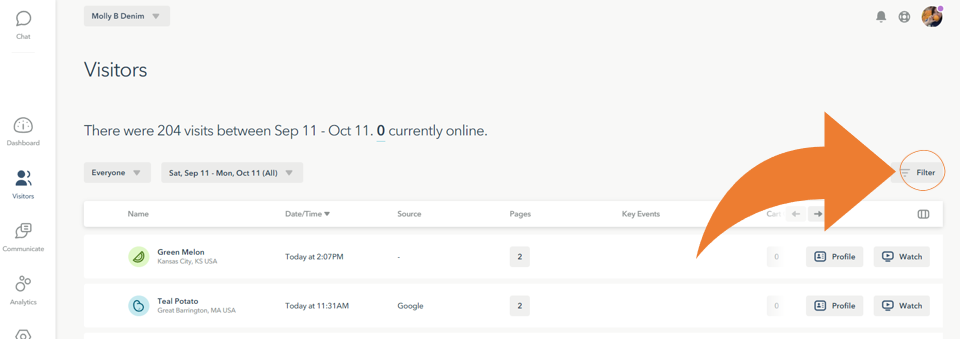Moving from Classic: How to pass in custom user data
In this article:
- What is custom user data?
- How to pass in custom user data
- Moving from Classic: Will I have to update my custom user data for new app?
- Where do you find custom user data in Lucky Orange?
What is custom user data?
By default, Lucky Orange collects information about your visitors, such as their geographic location and browser type. But what if you want more information to pass into Lucky Orange? You can do that with custom user data.
Lucky Orange lets you pass in any custom data you’d like, such as the customer’s:
- Name
- Nickname
- Email address
- Loyalty number
- Favorite color
- Pet name
- Preferred clothing size
As you can tell, there is no limit to the custom data you can pass in.
How to pass in custom user data
To start to pass custom into Lucky Orange, you need to use a bit of JavaScript. In particular, you will use the identity () API. For developer-specific instructions, click here.
Moving from Classic: Will I have to update my custom user data for new app?
Because the code to pass in custom user data is unique to the new app, your previous code for custom user data used in Lucky Orange Classic won’t automatically move over. The code used to pass in custom user data in the new Lucky Orange app will need to be updated to continue passing in the data. Click here for instructions.
Where do you find custom user data in Lucky Orange?
With custom user data passing into Lucky Orange, you can:
- Get updated information when the visitor connects via Chat
- Create a segment to filter Session Recordings in the Visitors’ Table
- Find custom user data directly in the Visitor’s Profile page
- Save the saved segment to use to trigger for Surveys, Announcements and Chat Invites
Here’s how you would use custom user data and where you can find it within several features:
Get updated information when the visitor connects via Chat
Instead of being given a unique identifier, the custom data that is passed through also updates the name of the visitor once it’s been collected (e.g., a form or checkout). Instead of being referred to as Magenta Pepper or Teal Lemon, the visitor’s name will display the name that was entered by the user.
Create a segment to filter Session Recordings in the Visitors’ Table
- Navigate to Visitors from the left navigation
- Click on Filter, shown to the right above the Visitors’ table
- In the filter drawer that shows on the right, scroll to the bottom of the filter drawer to click on Custom User Data
- Select your desired Custom User Data from the list
- When finished, click the gray Save Segment button at the bottom of the filter drawer
- Enter an internal name for the segment. We recommended a specific name for easier use and search.
- Decide the visibility
- Everyone: The segment will show to everyone on your team
- Personal: The segment will be visible only to you
- Click the purple Save button
Once the segment is saved, you can then use the “Everyone” dropdown located in the right corner of the Visitors’ Table to jump to that specific segment. This will narrow all recordings to that specific set of filters.
Click here for more on creating and using segments.
Find custom user data directly in the Visitor’s Profile page
Whether you get there by searching the Visitors’ Table or from a Session Recording, the Visitor’s Profile will display the custom data that has been passed through and completed by the visitor. It will populate on the left side of the profile with all the custom user data the visitor completed.
Save the filter segment to use to trigger for Surveys, Announcements and Chat Invites
- Navigate to Communicate from the left navigation
- Begin creating your Survey, Announcements or Chat Invite
- Proceed through Step 1, which is creating the question (Survey), content (Announcements) or setup (Chat Invites)
- In Step 2: Trigger, select Advanced. By default, it will be set on Simple.
- Select Segment from the rule dropdown
- Click on the desired segment from the dropdown list
- Repeat with AND or OR rules for additional segments or rules
- AND: A visitor completes both/all rules. For example, the Survey, Announcement or Chat Invite would only show to the dog owners segment AND came from Facebook.
- OR: A visitor completes any of the set rules. For example, the Survey, Announcement or Chat Invite would show to anyone who is in the dog owners segment or came from Facebook, regardless of whether they occurred together.
- Proceed through the setup process
Example
Let’s say you want to pass in custom user data for your pet supply website. You want to pass in the pet type, which is a question visitors fill out during checkout. Once a the custom user data is set to begin passing pet type into Lucky Orange, you would:
- See the pet type directly within the Visitors’ Profile pages
- Know your visitor’s name when they Chat with your team
- Create a segment just for dog owners
- Use the dog owner segment to trigger Surveys, Announcements and Chat invites to show only to those customers who are known to be dog owners